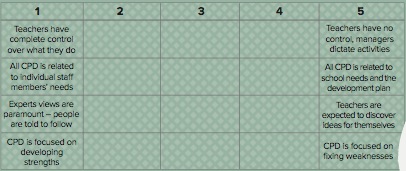EFFECTIVE CPD BENEFITS LEARNERS AND EDUCATORS ALIKE, BUT IT’S ESSENTIAL TO GET THE RIGHT MIX OF INGREDIENTS, AS DAVID WESTON EXPLAINS...
Think about the way staff members at your school engage with continuing professional development (CPD). Where, on the scales shown in the following table, is your school?

Great CPD
There is a lot of international research into the types of professional learning that engage and inspire as well as deliver genuine, positive impact on pupil learning. The consistent message is that the following characteristics need to be built in:
Aspirational
CPD experiences are far more successful when they are designed to help teachers achieve their aspirations for their pupils. CPD should aim to solve learning/ behaviour problems that participants care about or build on strengths/dispositions that they feel are important. Not all CPD will do this directly, so it’s important to try and help teachers see the links between their personal goals and the work they’re doing.
Learning-focused
The most effective professional development focuses on specific areas of learning of behaviour rather than simply aiming to change the way the teacher practises. For example, “improving history essay structure for EAL pupils through targeted use of formative feedback” rather than simply “improving assessment for learning” leads to more focused professional learning which makes it easier for the participant to evaluate and refine their approach.
Collaborative
When a team of teachers jointly tackle a professional learning activity then the ensuing debate, discussion and developing relationships strengthen the effectiveness of the experience. Triads are often particularly powerful to ensure that there are enough different viewpoints and support.
Relevant & differentiated
Nothing is more off-putting than being forced to attend training which is irrelevant to your current work and/or too hard or too easy. Teachers need enough support and challenge to be able to go away and try ideas out as soon as possible and then come back for further discussion. However, if this is taken too far and every teacher does something different then you lose the opportunity to develop a shared language and understanding of pedagogy.
Sustained & cycled
One of the surprise results from the research is that, on average, only those professional development processes that lasted at least 30 hours had any sustained positive impact on pupil learning. This time includes training, discussion, teaching, reflection, observation and informal thinking. It’s easy to see that school staff members are undertaking six different strands of CPD every year then it is unlikely that any will make a long-term impact.
Evaluated
We know that pupils need regular formative feedback in order to improve their understanding and skill. The same is absolutely true of teachers who need to be able to objectively assess the impact they are having and refine/adapt their approach.
Challenging as well as informative
Some of the most powerful learning occurs when professional development causes a teacher to re-evaluate their fundamental beliefs around mechanisms of learning and effective teaching. CPD which is merely enjoyable ‘fluff’ with lots of tips and tricks is unlikely to lead to a significant and fundamental change in practice.
Lead by example
The most effective schools create a culture where learning is openly modelled by all senior staff, where experimentation and research are actively encouraged and supported, and where even the most experienced teachers are open to constructive feedback. When senior leaders become ‘lead learners’ who are willing to take risks and make themselves vulnerable then this permeates through the school and creates an effective CPD culture.
Practical Examples
In practice, schools approach CPD in a number of ways. Cramlington Learning Village timetables two hours of staff collaboration time every week on a Wednesday afternoon, having ended the school day slightly earlier than the rest of the week. This is used to collaborative planning, research, coaching and other team-based CPD activities. They have a very structured induction programme which is tightly specified for NQTs and then becomes more self-directed as you move through their NQT+1, NQT+2 and NQT+3 programmes, which contain increasing elements of leadership and research work.
At Wroxham School most staff undertake research or enquiry work and then lead the dissemination, implementation and embedding of their findings throughout the school. All staff, including teaching assistants, meet regularly to discuss research papers and the school has published a book (Creating Learning Without Limits) about its approach in association with a University.
Bethnal Green Academy has two members of the governing body who










